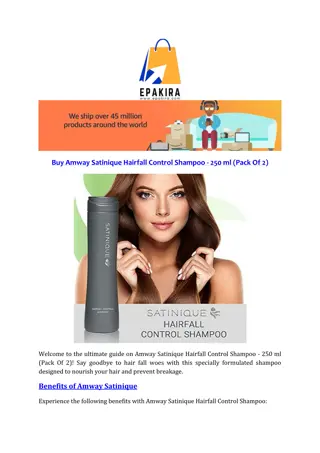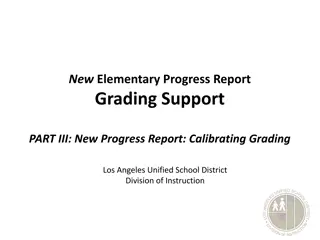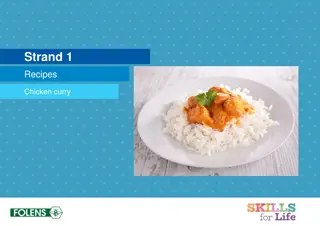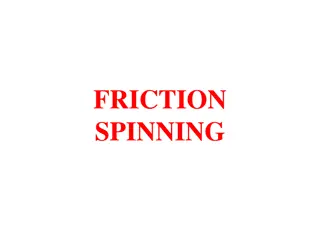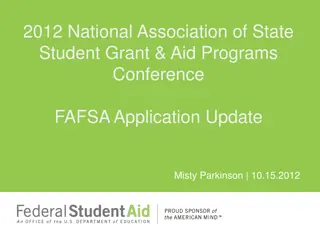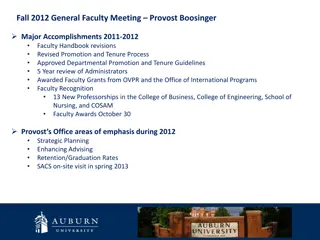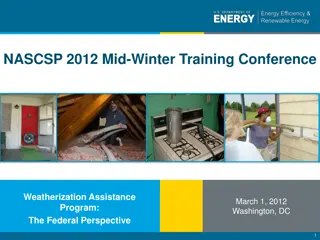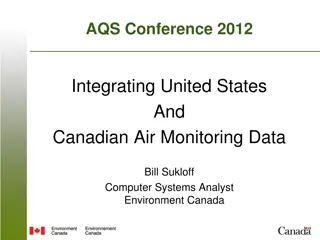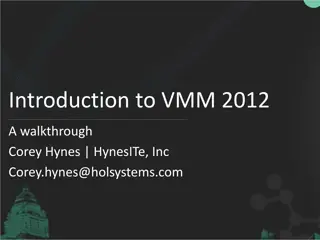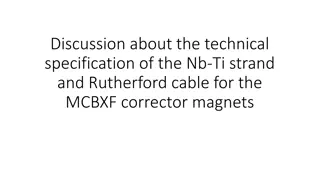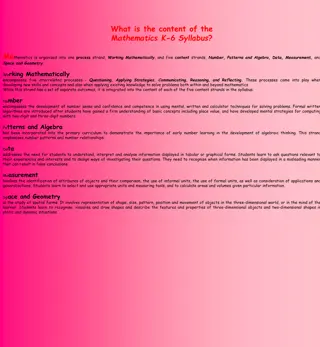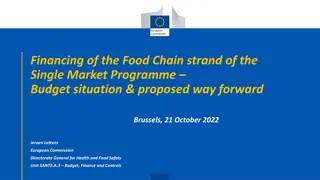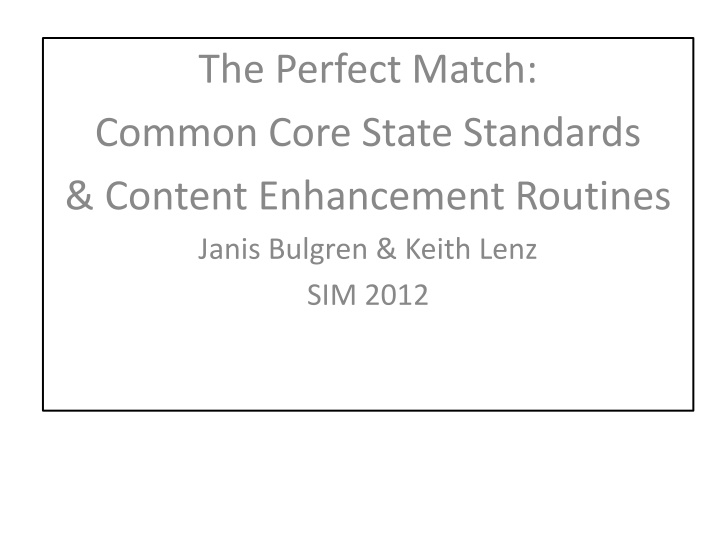
Higher Order Thinking in Common Core State Standards
Explore how Content Enhancement Routines align with the challenges of responding to higher order thinking demands in the Common Core State Standards. Discover critical questions, big picture concepts, and results for literacy development.
Download Presentation

Please find below an Image/Link to download the presentation.
The content on the website is provided AS IS for your information and personal use only. It may not be sold, licensed, or shared on other websites without obtaining consent from the author. If you encounter any issues during the download, it is possible that the publisher has removed the file from their server.
You are allowed to download the files provided on this website for personal or commercial use, subject to the condition that they are used lawfully. All files are the property of their respective owners.
The content on the website is provided AS IS for your information and personal use only. It may not be sold, licensed, or shared on other websites without obtaining consent from the author.
E N D
Presentation Transcript
The Perfect Match: Common Core State Standards & Content Enhancement Routines Janis Bulgren & Keith Lenz SIM 2012
The Challenge Responding to the higher order thinking challenges in the Common Core State Standards (CCSS) is important for teachers and professional developers in our schools.
The Response: Don t reinvent the Wheel !!! Content Enhancement is ready-made to respond to Common Core State Standards.
The Response: A Good Match Fortunately, the higher order thinking challenges in the Common Core State Standards (CCSS) are often already addressed in Content Enhancements (CE). This interactive thinking and planning session will help us collaboratively answer critical questions about the CCSS & CE.
Critical Questions What are the higher order thinking demands in the Common Core State Standards? How do these higher order thinking demands grow increasingly complex across grade levels? How are these demands similar across curricular areas (science, social students, English Language Arts)?
Big Picture The Common Core State Standards quickly move beyond factual information to higher order reasoning. The challenges mirror what professional developers already know about developing critical questions on the Course Organizer, Unit Organizer, and Question Exploration Guide: Ask questions that begin with How and Why rather than Who, What, Where, and When.
Results for Literacy The Common Core State Standards for English Language Arts & Literacy in History/Social Studies, Science, and Technical Subjects Literacy now encompasses more expanded components. Basic reading, writing, listending, and speaking skills are the foundations for demonstrating higher order thinking and reasoning.
Are there higher order thinking patterns in the CCSS? Analysis of College and Career Readiness Anchor Standards for Reading in the CCSS (p. 60) provides a starting point for identifying the overall pattern of higher order thinking in the CCSS. Activity 1
CCSS Thinking Patterns Key Ideas and Details Craft and Structure Integrate knowledge and Ideas Range
Organize Information NAME DATE Unit Organizer 4 BIGGER PICTURE Helping all Student Succeed NEXT CHAPTER LAST CHAPTER 2 3 CURRENT UNIT 1 Patterns Across CCSS 8 CHAPTER SCHEDULE CHAPTER MAP 5 The CCSS focus on four goals in a repeated pattern Providing foundations with that can result in Key Ideas must be understood by Learned by analyzing Range Craft & Structure Integration 6 7 SELF-TEST QUESTIONS Comparison Question Exploration RELATIONSHIPS Cause-Effect Evaluate Arguments
The Response: Don t reinvent the Wheel !!! Content Enhancements already ENCOMPASS many of the higher order thinking demands presented in the Common Core State Standards.
Specific Thinking Challenges: Anchor Standards in Reading Key Ideas and Details: Determine information, make inferences, cite evidence, draw conclusions Determine central ideas or themes , their development and summarize Analyze development of people, events and ideas. Craft and Structure Interpret words and phrases Analyze structure of text to get the big picture Assess point of view or purpose Integrate knowledge and Ideas Integrate and evaluate content in different formats Identify and evaluate arguments, claims, reasoning and evidence Compare approaches to different themes or topics Range
Higher Order Thinking Challenges Specific Overall Key Ideas and Details: Determine information, make inferences, cite evidence, draw conclusions Determine central ideas or themes , their development and summarize Analyze development of people, events and ideas. Comprehend complex information Comprehend critical ideas Analyze development, process, causes Craft and Structure Interpret words and phrases Analyze structure of text to get the big picture Assess point of view or purpose Interpret meanings and concepts Analyze text structure Determine author s goals Integrate knowledge and Ideas Integrate and evaluate content in different formats Identify and evaluate arguments, claims, reasoning and evidence Compare approaches to different themes or topics Compare and integrate Evaluate argumentation Compare and contrast Range
CCSS Thinking Structures & CEs Key Ideas and Details: complex information critical ideas development, process, causes Unit Organizer Question Exploration Sequence and Causation Craft and Structure meanings and concepts text structure author s goals Concept Mastery, Anchoring Unit Organizer Question Exploration Integrate knowledge and Ideas evaluation, comparison, integration of info. argumentation evaluation comparison and contrast of ideas Question Exploration Argumentation & Explanation Concept Comparison Range
The Match: Organizer Routines for Organizing and Linking The Map: organize information The linking lines complete meaning Critical Concepts highlighted The Thinking Relationships Cued The Critical Questions identified for development of Thinking Routines
Critical Concepts Thinking & reasoning patterns Organize Information NAME DATE Unit Organizer 4 BIGGER PICTURE Investigating Problems & Solutions NEXT CHAPTER LAST CHAPTER Biosphere 2 3 CURRENT UNIT 1 Human Use of Resources Environmental Solutions 8 CHAPTER SCHEDULE CHAPTER MAP 5 The effects of human use of natural resources on the earth s environment Line links 12-1 Our Environment p. 635 based on Understanding of that can result in Our 12-2 Pollution must be understood by can result in for meaning environment p. 641 Environmental problems 12-3 Resources p. 646 Types of resources Pollutio n 12-4 Problems p. 650 12-7 Project Due in that are Air Land Water Renewable Non-renewable Critical Questions 12-8 Test 6 7 1. 2. Why is pollution a problem? How are renewable and non-renewable resources alike and different? How does burning a tropical rain forest affect our environment? How do effects of useful products cause problems for the ozone layer and for humans? SELF-TEST QUESTIONS Comparison Analogy RELATIONSHIPS Cause-Effect 3. 4. Problem-Solution
The Match: Question Exploration It s all about critical questions and Main Idea Answers Key Ideas and Details: Determine information, make inferences, cite evidence, draw conclusions Determine central ideas or themes , their development and summarize Analyze development of people, events and ideas. Craft and Structure Interpret words and phrases Analyze structure of text to get the big picture Assess point of view or purpose Integrate knowledge and Ideas Integrate and evaluate content in different formats Identify and evaluate arguments, claims, reasoning and evidence Compare approaches to different themes or topics Range
SUMMARIZATION Of Main Ideas QUESTION GENERATION Critical Questions Our Environment Science 12 4 Critical Questions Question Exploration Guide Lydia L. Text Reference Course Unit Name: Human Use of Resources Title Critical Question #: 4 1-25-06 Lesson Date: 1 What is the Critical Question? How do effects of useful products cause problems for the ozone layer and for humans ? 2 What are the Key Terms and explanations? Environment = All the things surrounding us - air, land, water, living things Invisible layer of gas that shields us from ultraviolet rays harmful rays from the sun. Ozone layer = Ultraviolet (UV) rays = Words & Phrases Critical Development, Evidence, Point of View 3 What are the Supporting Questions and answers? What happens to the ozone layer? How do products cause problems? What happens when chemicals are released? Why is it a problem if ozone is not formed? What do UV rays of the sun cause? The ozone layer is being hurt by household products we use on earth. Products like hair spray contain chemicals that are released into the air. When chemicals like chlorine are released into they air, they keep ozone from being formed in the stratosphere. This is a problem because ozone protects us from UV rays of the sun. UV rays cause skin cancer and disrupt weather and crop production. THE BIG PICTURE, CONCLUSIONS & SUMMARIZATION 4 What is the main Idea answer? Useful products that contain chemicals can disrupt the formation of ozone with bad effects on living things, the weather and crops. 6 5 Is there an Overall Idea? Is there a real-world use? How can an individual who thinks there is a problem with ozone respond at home? How can we use the main idea? How can we explore the effects of chemicals for ourselves?
The Match: Concept Mastery & Concept Anchoring Key Ideas and Details: Determine information, make inferences, cite evidence, draw conclusions Determine central ideas or themes , their development and summarize Analyze development of people, events and ideas. Craft and Structure Interpret words and phrases Analyze structure of text to get the big picture Assess point of view or purpose Integrate knowledge and Ideas Integrate and evaluate content in different formats Identify and evaluate arguments, claims, reasoning and evidence Compare approaches to different themes or topics Range
Acquire big picture understandings Knowledge of word & phrases Apply reasoning & analysis CONCEPT DIAGRAM CONVEY CONCEPT Key Words Pollution Contamination OFFER OVERALL CONCEPT Waste NOTE KEY WORDS CLASSIFY CHARACTERISTICS Acid rain Always Present Sometimes Present In air In water On land Never Present Decompositio n Recycled by nature Harm Presence of wastes In the air Wastes are too great to Causes harm be recycled by nature Smog Wastewater Examples: Nonexamples: EXPLORE EXAMPLES Smog Clouds Dumps Acid rain Greenhous e gases? Treated wastewater Recycled by nature Non-decomposed dumps Main Idea, Conclusion, Summary Recycled plastics PRACTICE WITH NEW EXAMPLE Pollution is a form of contamination in which harm is caused by the presence of wastes that are too great to be recycled by nature. TIE DOWN A DEFINITION
Acquire content knowledge Reason by Analogy, Inference Comparison 12 Main Ideas Anchoring Table Unit: 12/2/06 Name: Hannah B Date: 3 Known Concept Roof on a house (from outer to inner) 2 1 New Concept Known Information Layers of the Atmosphere (from outer to inner) Characteristics of Known Concept Characteristics Shared fourth and last layer before space Characteristics of New Concept thermospher e mesosphere 6 4 5 insulation shingles or tiles shingles tiles wood third layer tarpaper stratosphere (contains the ozone layer) second layer tarpaper plywood & insulation wood supports & rafters first layer closest to where we live troposphere 7 Understanding of the New Concept: The four layers of the atmosphere have different locations and components. 4 Highlight Characteristics of Known Concept 5 Observe Characteristics of New Concept 6 Reveal Characteristics Shared 7 State 1 Announce the New Concept 2 Name 3 Collect ANCHORS Linking Steps: Understanding of New Concept Known Concept Known Information
The Match: Concept Comparison Key Ideas and Details: Determine information, make inferences, cite evidence, draw conclusions Determine central ideas or themes , their development and summarize Analyze development of people, events and ideas. Craft and Structure Interpret words and phrases Analyze structure of text to get the big picture Assess point of view or purpose Integrate knowledge and Ideas Integrate and evaluate content in different formats Identify and evaluate arguments, claims, reasoning and evidence Compare approaches to different themes or topics Range
Comparison & Integration C Communicate targeted concepts O Obtain the Overall Concept M Make lists of known characteristics P Pin down Like Characteristics A Assemble Like Categories R Record Unlike Characteristics I Identify Unlike Categories N Nail down a summary G Go beyond the basics Inference & Generalization Comparison Table Content Informaiton 2 Overall Concept Resources 1 Concept Concept 1 Non-renewable resources (Metals, minerals, fossil fuels) Renewable resources (Oxygen, water, sunlight) 3 Characteristics 3Characteristics Part of natural environment Used by humans Replaced or recycled by nature Unlimited Part of natural environment Used by humans Not replaced or recycled by nature Limited 9 Extensions 4 Like Characteristics 5Like Categories Where found Evaluate the success of recycling efforts on two non- renewable resources Part of natural environment Used by humans Who uses Unlimited Replaced by nature Limited 6 Unlike Characteristics 7Unlike Categories Availability Not replaced by nature Replacement Draw Conclusion 8 Summary Renewable and non-renewable resources are both part of the natural environment on earth used by humans. They differ in availability and nature s ability to replace them.
The Match: Causal Reasoning Key Ideas and Details: Determine information, make inferences, cite evidence, draw conclusions Determine central ideas or themes , their development and summarize Analyze development of people, events and ideas. Craft and Structure Interpret words and phrases Analyze structure of text to get the big picture Assess point of view or purpose Integrate knowledge and Ideas Integrate and evaluate content in different formats Identify and evaluate arguments, claims, reasoning and evidence Compare approaches to different themes or topics Range
Big Picture Analyze development Evaluation Cause and Effect Table Name: Cole D._________________ Date:12.3.06_______ Unit: 12_________________ Lesson/Topic:_Environmental Problems __ How does burning in a rain forest affect our environment? Key Words: rain forest-dense evergreen forest in rainy, usually hot, areas carbon dioxide-gas formed in respiration, combustion & decomposition during the 20th century Today 1 Question: 2 Atmosphere - gaseous mass surrounding the earth Sequence 3 Before 20th century 6 End Result(s) The entire earth is becoming warmer, even though the rain forest is being destroyed in the tropics. 4 Cause(s) Action(s) Effect(s) 5 Describe Beginning Situation: Tropical rain forests remove carbon dioxide from the atmosphere and create oxygen to keep the atmosphere in balance. Burning the forest releases carbon dioxide into air. Increased carbon dioxide in the atmosphere traps heat energy and makes the earth hotter. Farmers cut rain forest to grow crops to feed more people. Fewer trees means less carbon dioxide is removed from the air. Conclusion: What happens in one part of the world can affect everyone. 7
The Match to CCSS: Argumentation and Evaluation Key Ideas and Details: Determine information, make inferences, cite evidence, draw conclusions Determine central ideas or themes , their development and summarize Analyze development of people, events and ideas. Craft and Structure Interpret words and phrases Analyze structure of text to get the big picture Assess point of view or purpose Integrate knowledge and Ideas Integrate and evaluate content in different formats Identify and evaluate arguments, claims, reasoning and evidence Compare approaches to different themes or topics Range
Argumentation & Evaluation Guide Identify claim, evidence, reasoning Determine information Topic/Title A Little Lead is Too Much Source Environmental Health Name: Teacher Date: _____________________________________ point of view Assess purpose & What is the Claim, including any Qualifiers)? (underline qualifiers) If the CDC cut the current acceptable lead level in the blood in half for children up to age 6 and enforced it, they would perform better on intelligence testing. 1 What Evidence is presented? Identify each as data, fact, theory or opinion. 4 2 What type of reasoning proves the evidence supports the claim? (Identify as authority ,analogy, correlation, cause and effect, theory, principles or generalization) A published study followed 200 children from 6 months to 6 years testing a total of 8 times and found that children with lead concentrations from 5 to 9.9 micrograms per deciliter preformed an average of 4.9 points lower on their IQ tests. (data) The published study was well designed and cited. (authority) The assumption was made that what was true for the sample group of 200 children is true for all children. (generalization) In 2001, the head of the CDC said the acceptable level would probably be changed from 10 to 5 micrometers per deciliter of blood, but a change in committee changed that decision. (opinion) Higher lead levels in the blood reduce IQ performance. (cause and effect) Lower rates were requested by the Independent Clean Air Scientific Advisory Committee. (fact) Eliminating lead in gasoline resulted in a sizeable increase in IQ levels in children throughout the country. (fact) Evaluate the evidence as poor, average or excellent and explain (Use reliability, validity, objectivity, well designed experiment). 3 5 Evaluate the source s reasoning as poor, average or excellent and explain. (Use logic, accepted ways of thinking, false assumptions) The published study was valid and well designed. (Excellent) The other evidence is not well supported by facts, but I have heard of the CASAC (average) I think the sources reasoning is excellent. It was based a good source and was logical. 6 What are concerns about (sources of error, counterarguments, questions)? Note if concerns are from source or reader. Some members of the CDC Advisory Committee are from the lead industry. EPA does not want to enforce lower standards. Conclusion: Accept/reject/withhold judgment. Present and summarize your reasoning. I accept the claim that lead level standards in children should be lowered based on the arguments in the article. The research cited is an excellent source and earlier changes as a result of removing lead from gasoline seem to support the Claim. 7 C Bulgren revised 2/15/2008
Is there a CCSS Match for higher order thinking across grade levels? Analysis of grade levels K-12 indicates * the emphasis on higher order thinking and reasoning in incrementally more complex ways, *while maintaining a core pattern. Activity 2
Is there a CCSS match across Content Areas? Analysis across content areas indicates * the emphasis on higher order thinking and reasoning in incrementally more complex ways, * repeated across content areas to achieve multiple exposures. Activity 3
The Match: Science Framework and Next Generation Cross Cutting Concepts: Patterns and Causes & Effects (Framework, selected) Selected Next Generation Practices: 1. Asking questions and defining problems 2. Constructing Explanations 3. Engaging in argument from evidence 4. Obtaining, evaluating, and communicating information.
Sample Performance Tasks Informational Texts History/Social Studies & Science, Mathematics and Technical Subjects English Language Arts
Patterns in Mathematics Mathematical Practice Standards (Pattern) Reason abstractly. Construct arguments. Critique the reasoning of others. Look for and make use of structure. Look for an express regularity in reasoning. Repeated challenges: Interpret Summarize Understand processes Evaluate Make inferences Understand relationships Analyze Apply Reasong
Ties To Texts Many texts, and the higher order thinking challenges found at the end of chapters clearly indicate the need for this higher order thinking.
Samples from Texts HRW: American Nation: Comparing and Contrasting: What was the popular image of a mother s role in the 1950 s? How did this image conflict with reality? Cause & Effect: How did concern over nuclear weapons influence Kennedy s foreign policy? Point of View: Why did many members of Congress oppose President Kennedy s tax-cut proposal? Evaluate: How did the Warren Court s decisions in Miranda v. Arizona strengthen individual rights?
SIM Challenges How would integrated sets of Content Enhancement Routines illustrate to the field that these routines can facilitate and increase the learning specified in the Common Core State Standards? How can professional development be leveraged across grade levels and curricular areas to produce more intensive use of a range of multiple, well-selected, devices that will support both teachers and students
Ties to Professional Development How can professional development be leveraged across grade levels and curricular areas to produce more intensive use of a range of multiple, well-selected, devices that will support both teachers and students as they respond to the Common Core State Standards?
What do the CCSS say about student with learning disabilities? Instruction for students with disabilities must include: Supports to enable access to the general curriculum An Individualized IEP designed to attain grade-level standards Specialized teachers prepared to deliver support services Supports and services may include: Universal Design for Learning instructional supports Instructional accommodations Assistive technology devices and services
How Principles of Content Enhancement support these goals? Content Enhancement principles: Th3 integrity of the content information is maintained. Teacher is the content expert Teacher mediates learning by selecting critical features of the content and transforming them in a manner that promotes learning. Instruction for academically diverse groups of students meets both group and individual needs.
Whats our Conclusion? Don t reinvent the Wheel !!! Content Enhancement supports many of the goals contained in the Common Core State Standards while adhering to what we know about supporting students with learning disabilities in the general education classroom.

